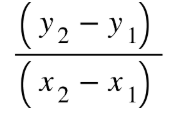Need to Know Math Formulas for ACT
Pre-Algebra / Elementary Algebra
1. Average = Sum of values / Number of values
Used to calculate the mean value of a given set of numbers. For example: (10 + 12 + 14 + 16) / 4 = 13
2. Probability = Target outcomes / Total outcomes
Used to calculate the chances of something occurring from a set of possible outcomes. For example: A jar contains five blue marbles, five red marbles, and ten white marbles. What is the probability of picking a red marble at random? 5 / 20 = .25 or 25%
3. Quadratic Formula:

Used for determining the x-intercepts of a quadratic (parabolic) equation.
Intermediate Algebra / Coordinate Geometry
4. Distance Formula:

Used to calculate the distance between two points on a coordinate plane. For example: Find the distance between points (6, 6) and (2, 3) d=√(6 – 2)² + (6 – 3)² d=√(4)² + (3)² d=√16 + 3 d=√25 d = 5
5. Slope Formula: Slope =

Used to calculate the slope (angle) of a line that connects two points on a plane. For example: Coordinates = (-2, -1) (4, 3) s = 3 – (-1) / 4 – (-2) s = 4 / 6 s = 2 / 3
6. Slope Intercept: y=mx+b
Formula that defines a line on a plane, given a known slope and y-intercept. For example: Slope = 2, Intercept point (0,3) y = 2x+3
7. Midpoint Formula:

Used to calculate the midpoint between two points on a plane. For example: Find the midpoint between (-1, 2) and (3, -6) (-1 + 3) / 2, (2 + -6) / 2 2 / 2, -4 / 2 Midpoint (1, -2)
Plane Geometry
8. Area of Triangle: area = (1/2) (base) (height)
Used to calculate the total area within a triangle based on the lengths of the sides. For example: Base = 5, Height = 8 a = 1/2 (5)(8) a = 1/2 (40) a = 20
9. Pythagorean Theorem: a²+b²=c²
Used to calculate the length of an unknown side of a right triangle, given two sides are known. For example: a = 3, b = 4 c² = 3² + 4² c² = 9 + 16 c² = 25 c = √25 c = 5
10. Area of Rectangle: area = length x width
Used to calculate the total area within a rectangle shape. For example: length = 5, width = 2 a = 5 x 2 a = 10
11. Area of Parallelogram: area = base x height
Used to calculate the total area within a parallelogram. For example: base = 6, height = 12 a = 6 x 12 a = 72
12. Area of Circle: π * r²
Used to calculate the total area within a circle. For example: radius = 4 a = π x 4² a = π x 16 a = 50.24
13. Circumference of Circle: circumference = 2π * r
Used to calculate the length of the outline of a circle. For example: radius = 7 c = 2π x 7 c = 43.98
Trigonometry
14. Sine (SOH): Sine = opposite / hypotenuse
For example: opposite = 2.8, hypotenuse = 4.9 s = 2.8 / 4.9 s = 0.57
15. Cosine (CAH): Cosine = adjacent / hypotenuse
For example: adjacent = 11, hypotenuse = 13 c = 11 / 13 c = 0.85
16. Tangent (TOA): Tangent = opposite / adjacent
For example: opposite = 15, adjacent = 8 t = 15 / 8 t = 1.87
